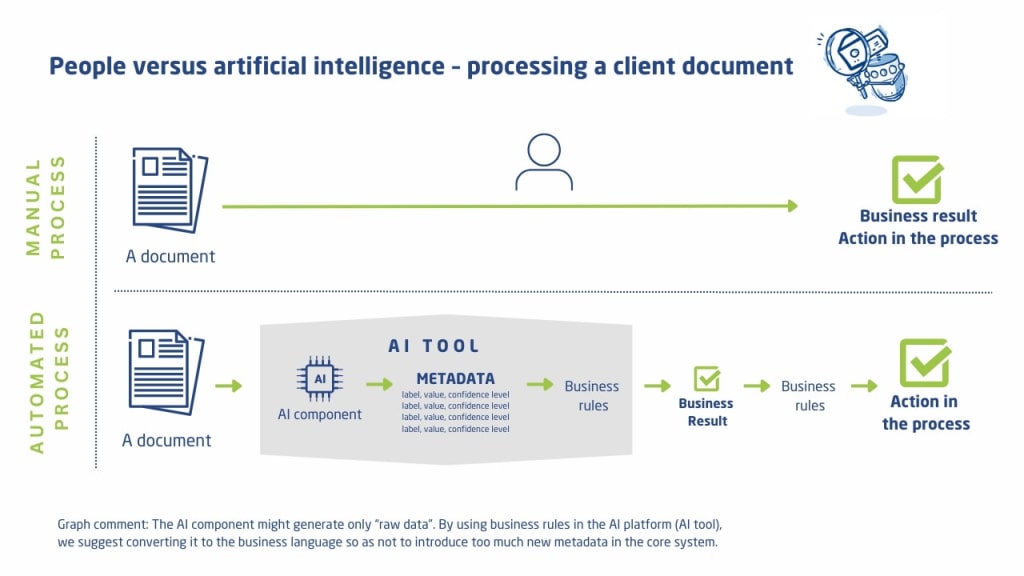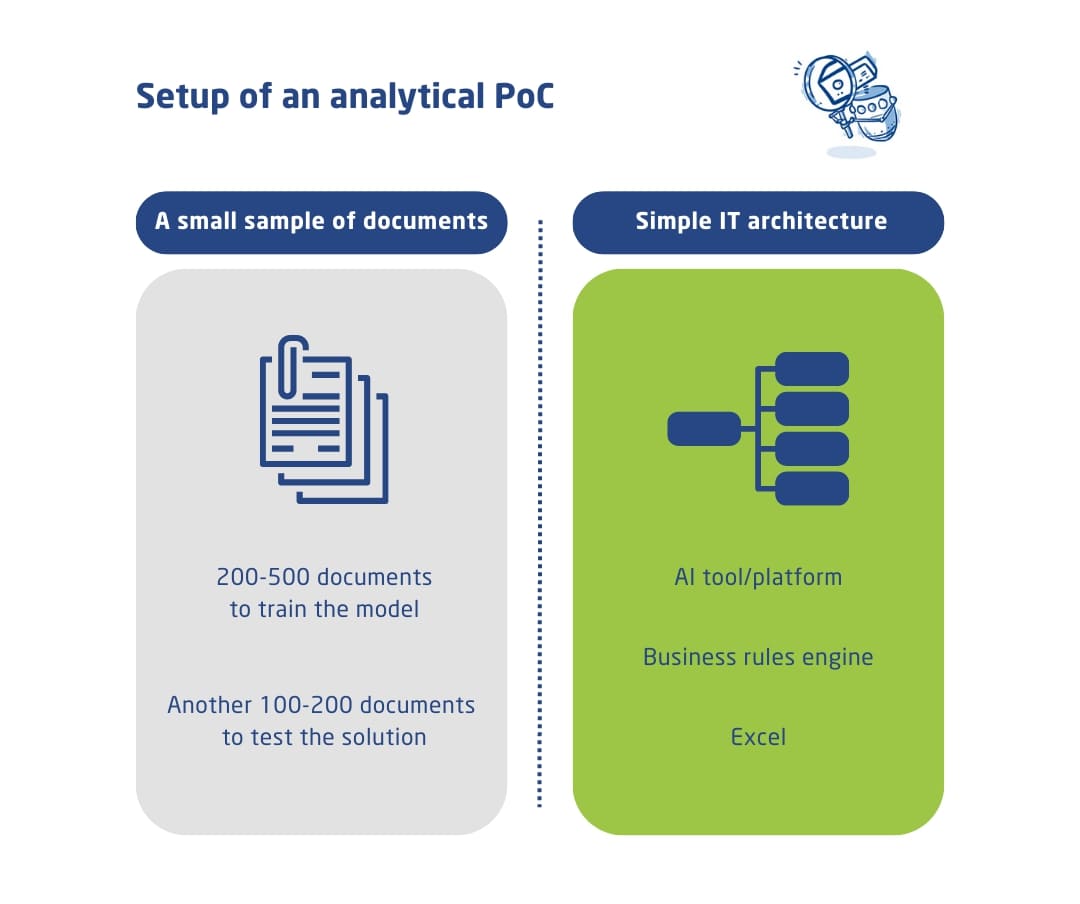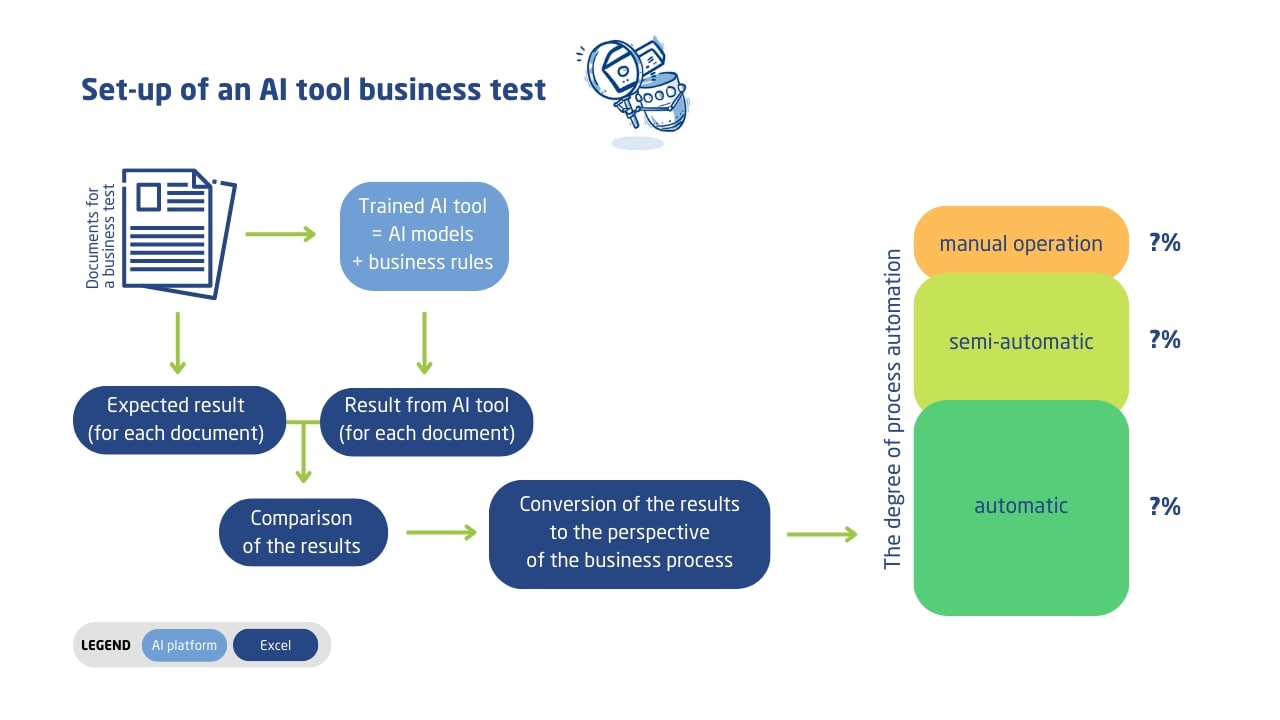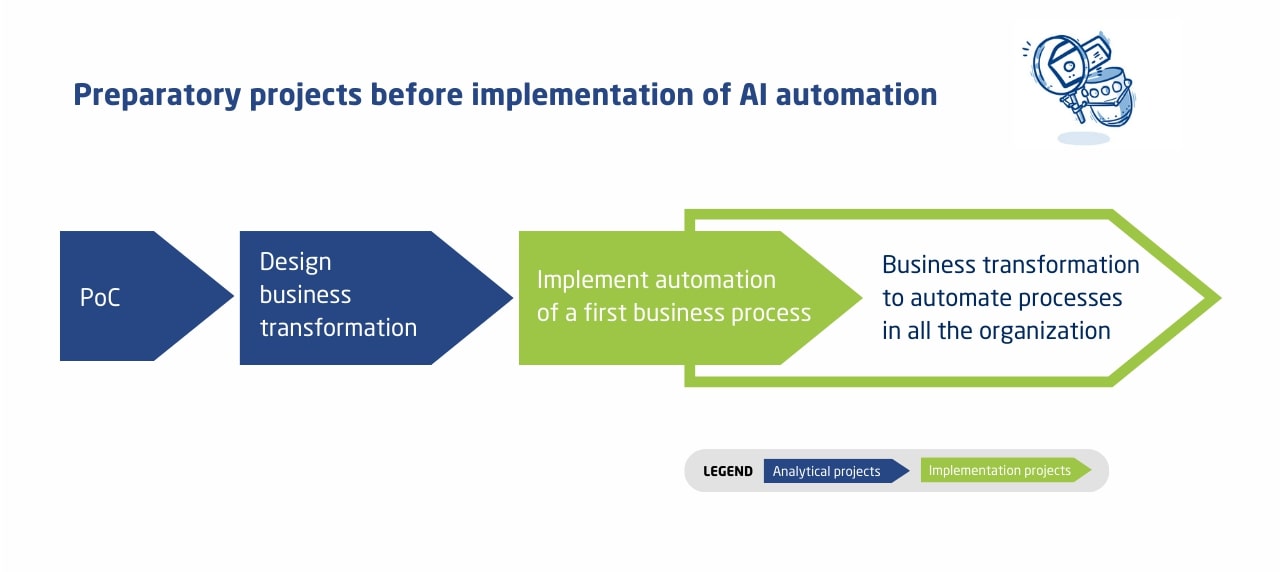Why do I need a PoC (Proof of concept)?
There is not yet a universal AI tool that you can use to solve every business problem. There are a variety of AI tools for business, and you need to find the ones that are right for solving your specific problems. At Sollers Consulting, we focus on easy-to-train tools that are available on cloud platforms and can recognise the information given in a document, classify different documents, recognise some features of an image and much more.
Insurance examples for AI automation
Her are a few examples to give you an idea of what could be automated in insurance using these tools.
- Reading incoming customer emails, using chatbots to answer customer questions, splitting combined documents into individual documents, classifying attached documents, reading information and setting up a claim or activity for a user in claims handling, underwriting or customer service.
- Analyse claim documents (medical statements, expert reports, police notes, vehicle or personal documents, statements of the injured party, invoices) to determine symptoms of fraud, special circumstances of the claim, possibilities of recourse, possibility of deduction of VAT, degree of liability in the event of a claim.
- Analysis of documents such as medical descriptions of bodily injuries or invoices to determine the value of the damage.
- Review of vehicle images provided when taking out motor insurance.
Why not always ChatGPT
Of course, many of the readers are now asking why not just use ChatGPT to solve all these problems. I recommend choosing a tool that is no more complex than required to solve a particular problem. Otherwise, the implementation and operational costs could be high and the quality of the result lower than required. In particular, if you can automate a business process without using AI, this would generally be the recommended approach.
Here are some arguments against ChatGPT for simple AI automation: ChatGPT does not provide structured data out of the box, nor is it trained to your specific needs or context. You can ask ChatGPT to provide the confidence level of its results, but would the confidence level be correlated with your specific business context?
With simple AI tools used to recognise information from a document, you get a list of structured data with certain confidence levels that you can use directly to automate a specific business process in a controlled way, simply by applying business rules.
The challenge of AI automation – architecture implications
There is a lot of opportunites AI enables for insurers. However, if you want to automate processes with AI, you will need to change your architecture – including introducing lots of new metadata and lots of new business rules, modifying user interfaces to handle cases that are not fully automated, and (not just optimising, but) redesigning business processes to take advantage of the new capabilities.
These can be costly changes, especially if they were not well thought out beforehand. Therefore, most probably, you would not want to change the architecture for only one automation.
I recommend first doing an analytical project to structure the target solution, define high-level assumptions and plan a step-by-step approach to implementation. The idea is to implement the target solution incrementally, combining aligned blocks to maximise business value while minimising implementation costs.
Just to be clear – there is a common cliché that “planning does not mean agile”. Yes, implementation can be done fully agile – planning is done at the architecture level and does not aim to design the final result in detail at the very beginning.

Why to make PoC (Proof of Concept)
Many would say why should I invest in an analytical project when I have no idea what will come out of it except that nothing will be implemented. The answer is: do a simple PoC project to address these questions:
- What are the key areas where I can automate my business process with AI?
- Will AI be able to do the job for me?
- What would be the cost of maintaining AI tools?
- How big is the potential benefit?
- How big is the impact on the target architecture?
As a decision maker, not only will you have a better overview of the future, but your team will also get a first idea of what AI is all about, and most importantly, when you see AI working for you, your team should become highly motivated. With motivation you can move mountains, and you need it, because as a company you will most likely have to learn and change a lot in order to make an AI-enabled transformation.
Prepare Proof of Concept
Look at the current process and identify places that can be automated, look for relevant documents or images that could serve as input for the AI. Discuss with the AI expert what is feasible and what is not and whether the number of cases is sufficient to train the AI. Select the most representative automation possibility that has high potential for business benefits, is difficult, but still feasible for AI.
Consider running the PoC in a non-production environment but based on input (documents, images or data) from your production environment – simulate a real scenario with minimal cost.
You would need 300-700 documents, not just any documents, but documents that cover the scope of your PoC. You may not have a tag/index to filter out the documents you need from your core system – it could take a while to collect them. You may also need to anonymise them to feed the AI tools in the cloud test environment.

We recommend using an AI cloud platform to set up an AI tool. If your test requires processing some business logic, you may need to set up a simple decision engine, e.g. an executable version installed in the cloud AI environment and fed with a decision table delivered as input in an Excel file. You need a separate Excel file to recalculate and display the results.
Developing an AI tool for businness
Developing an AI tool for business involves designing a structure for the business logic, annotating training documents, training the AI model and defining business rules. This is an iterative process to devise the final version of the AI tool, which can easily be done by a business analyst and an insurance professional, with some assistance from a cloud and AI engineers.
Business test of an AI tool
The simple diagram explains the idea of a business test. You need to compare what the AI recognised and what it should have done – a simple comparison of data in Excel. You also want to know how these numbers translate into the level of process automation. These numbers serve as input for estimating various business benefits.

Business benefits of AI automation tools
Don’t miss the opportunity to estimate potential business benefits, as this would be a key point in making the “go forward” decision. There are “direct” benefits – the ones that can be precisely and easily estimated. These include:
- saving workload of daily operations – estimate share of different employee activities that could be automated,
- eliminating human errors – your audit department might have already estimated the annual value of claims leakage due to claim handler errors,
- shortening a process – search for processes where it brings direct value.
Additional “non-direct” benefits, which might be trickier to estimate, include:
- better fraud detection due to access to new data,
- improving customer experience due to redefining business processes at the customer front end,
- increasing employee satisfaction due to a more interesting and less stressful job.
Conducting a PoC is just the start of the journey. There is a lot to learn and discover. Treat AI automation as a journey, not a single event.

Piotr Kondratowicz
Business Architect at Sollers Consulting

